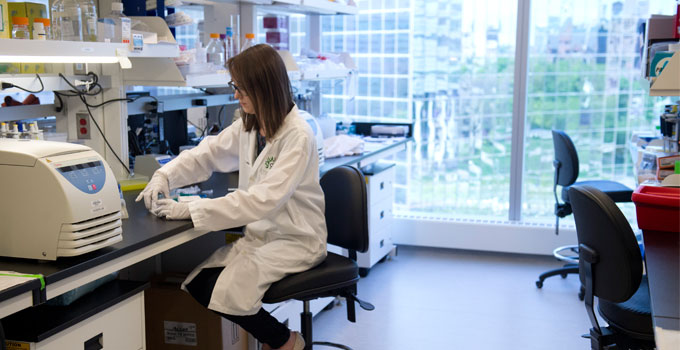
Polymerase chain reactions (PCR) are one of the most common tools used in molecular biology labs worldwide. This technique allows researchers to amplify, or increase, the amount of DNA in a sample so that they have more to work with. To keep track of the original molecules from a sample, chemical ‘barcodes’ are added. While barcodes serve an important purpose they can lead to errors and interfere with results. To prevent these cross-reactions a small team of international researchers have devised an ingenious method to ‘hide’ the barcodes when needed, leading to increased sensitivity and more reliable results.
To find out how the technology, called SiMSen-Seq, was created we spoke to Dr. Paul Krzyzanowski, Program Manager, OICR Genome Technologies. Krzyzanowski is one of the creators of SiMSen-Seq along with researchers from Sweden and the U.S.
How did the project get started and what problem were you and the team trying to solve?
Drs. Tony Godfrey and Anders Stahlberg and myself started working on SiMSen-Seq about two years ago. PCR is a very powerful and important tool in the lab, but unfortunately it can produce errors in the DNA amplified from the sample. This normally leads to an average error rate of about one per cent, so if you are looking for a particular mutation it has to be detected at a level about that threshold for the results to be reliable. To get around this, labs can use chemical tags called DNA barcodes that track the presence of the original sample molecules, however this presents another issue. Cross-reactions between sample molecules and the barcodes can create additional inefficiencies in PCR reactions, so we needed a way to prevent these cross-reactions.
What did you and the team do to address this issue?
We came up with a way to place the barcodes in a hairpin structure that opens up when heated to allow the barcodes to be read when needed and closes when cooled so that the barcodes do not interfere with PCR reactions. In addition we developed an analysis system that identifies and corrects other errors computationally. Tony and Anders’ lab experience, combined with my skills in bioinformatics, allowed us to create this technology.
How does this technology improve results?
As I said earlier, the typical error rate in sequencing is about one in 100. With SiMSen-Seq we have been able to routinely lower this error rate to about one in 10,000. In some experiments we have even gotten the rate down to one in 22,000. From a practical perspective, in terms of cancer, this means that we could find, for example, a recurrence of leukemia in a patient at much lower levels because the mutations we are looking for no longer need to be above the one per cent error rate. This means that these patients could potentially receive additional treatments much earlier than before.
What is happening now with this project?
Although we have patented our technique it can conceivably be used in any molecular biology lab following the steps laid out in our paper. However, it would still require a lab to go through a lot of trial and error to implement. Since we have a lot of experience in using SiMSen-Seq we are offering our expertise as a service to other research groups. Anyone who’s interested can access this service through OICR’s Collaborative Research Resources Directory.
